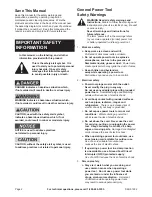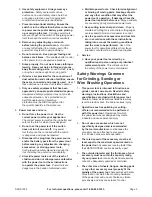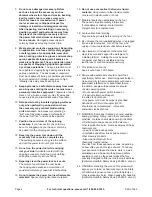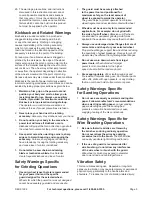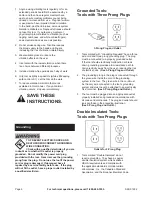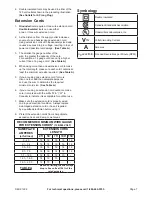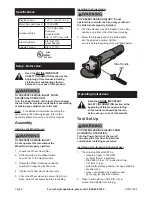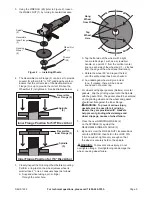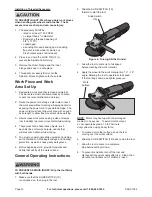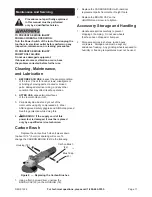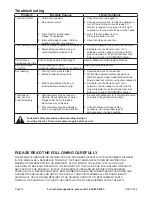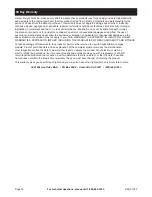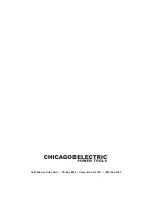
Page 4
For technical questions, please call 1-800-444-3353.
SKU 91222
7.
Do not use a damaged accessory. Before
each use inspect the accessory such as
abrasive wheels for chips and cracks, backing
pad for cracks, tear or excess wear, wire
brush for loose or cracked wires. If power
tool or accessory is dropped, inspect for
damage or install an undamaged accessory.
After inspecting and installing an accessory,
position yourself and bystanders away from
the plane of the rotating accessory and run
the power tool at maximum no-load speed
for one minute.
Damaged accessories will
normally break apart during this test time.
8.
Wear personal protective equipment. Depending
on application, use face shield, safety goggles
or safety glasses. As appropriate, wear dust
mask, hearing protectors, gloves and workshop
apron capable of stopping small abrasive or
work piece fragments. The eye protection must
be capable of stopping flying debris generated
by various operations.
The eye protection must
be capable of stopping flying debris generated by
various operations. The dust mask or respirator
must be capable of filtering out particles generated
by your operation. Prolonged exposure to high
intensity noise may cause hearing loss.
9.
Keep bystanders a safe distance away from work
area. Anyone entering the work area must wear
personal protective equipment.
Fragments of work
piece or of a broken accessory may fly away and
cause injury beyond immediate area of operation.
10.
Hold power tool by insulated gripping surfaces
only, when performing an operation where
the accessory may contact hidden wiring
or its own cord.
An accessory contacting a
″live″ wire may make exposed metal parts of
the power tool ″live″ and shock the operator.
11.
Position the cord clear of the spinning
accessory.
If you lose control, the cord may
be cut or snagged and your hand or arm may
be pulled into the spinning accessory.
12.
Never lay the power tool down until the
accessory has come to a complete stop.
The spinning accessory may grab the surface
and pull the power tool out of your control.
13.
Do not run the power tool while carrying
it at your side. Accidental contact with the
spinning accessory could snag your clothing,
pulling the accessory into your body.
14.
Regularly clean the power tool’s air vents.
The motor’s fan will draw the dust inside
the housing and excessive accumulation of
powdered metal may cause electrical hazards.
15.
Do not operate the power tool near flammable
materials. Sparks could ignite these materials.
16.
Do not use accessories that require liquid
coolants. Using water or other liquid coolants
may result in electrocution or shock.
17. Maintain labels and nameplates on the tool.
These carry important safety information.
If unreadable or missing, contact Harbor
Freight Tools for a replacement.
18. Avoid unintentional starting.
Prepare to begin work before turning on the tool.
19. Do not leave the tool unattended when it is plugged
into an electrical outlet. Turn off the tool, and
unplug it from its electrical outlet before leaving.
20. Use clamps (not included) or other practical
ways to secure and support the workpiece to
a stable platform. Holding the work by hand
or against your body is unstable and may
lead to loss of control and personal injury.
21. This product is not a toy.
Keep it out of reach of children.
22. People with pacemakers should consult their
physician(s) before use. Electromagnetic fields in
close proximity to heart pacemaker could cause
pacemaker interference or pacemaker failure.
In addition, people with pacemakers should:
• Avoid operating alone.
• Do not use with power switch locked on.
• Properly maintain and inspect
to avoid electrical shock.
• Any power cord must be properly grounded.
Ground Fault Circuit Interrupter (GFCI)
should also be implemented – it prevents
sustained electrical shock.
23. WARNING: Some dust created by power sanding,
sawing, grinding, drilling, and other construction
activities, contains chemicals known [to the State
of California] to cause cancer, birth defects or
other reproductive harm. Some examples of these
chemicals are:
• Lead from lead-based paints
• Crystalline silica from bricks and cement or
other masonry products
• Arsenic and chromium from
chemically treated lumber
Your risk from these exposures varies, depending
on how often you do this type of work. To reduce
your exposure to these chemicals: work in a well
ventilated area, and work with approved safety
equipment, such as those dust masks that are
specially designed to filter out microscopic particles.
(California Health & Safety Code § 25249.5,
et seq.
)
24. WARNING: Handling the cord on this product will
expose you to lead, a chemical known to the State
of California to cause cancer, and birth defects or
other reproductive harm. Wash hands after handling.
(California Health & Safety Code § 25249.5,
et seq.
)


